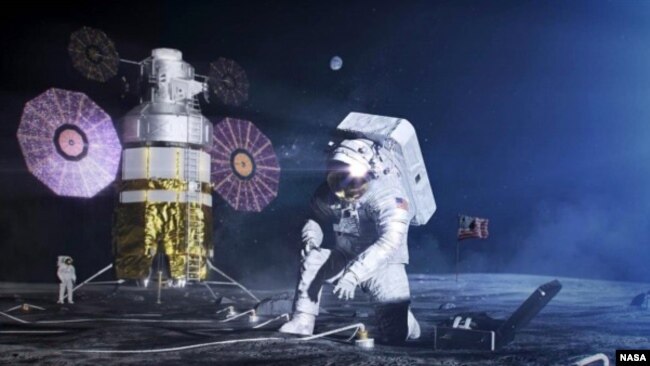アルテミス計画を担う通信網にノキア
地球は今や5Gの世界なのに、月は4Gなのですね~!!
MOON,と見ると、聞かずにはいられない。
この苛立ちと諦め。。。
しかも火星へ足がかりに侵略され、掘り起こされ、利用されるだけの、運命。
月が月としてそこにあるが故の運命!!
意志を持っていたのなら、月面は嵐が吹き荒れるかもしれませんね。
アルテミス計画の陰謀。
アルテミス計画については、目次から
NASA Releases Updated Plan for 2024 Moon Landing
今日のVOAニュースより( ;∀;)
NASA、月面での初のモバイルネットワーク構築にノキアを選択
NASA Chooses Nokia to Build First Mobile Network on the Moon
October 24, 2020
ノキアは、月面で初の携帯電話ネットワークを構築するために、アメリカの宇宙機関NASAに選ばれたと話しています。
フィンランドのテクノロジー企業は最近、そのノキア・ベル・ラボ部門が月面通信システムを構築すると発表しました。NASAはこの装置を月面着陸船に搭載するといっています。宇宙船は2022年後半に月面に到達すると予想されています。
宇宙機関が2024年までに宇宙飛行士を月に送るための準備を続けている中で、ノキアの発表がありました。NASAのアルテミス計画は、惑星火星への将来のミッションのための”ウォームアップ”として、月面に長期的な人間の存在を確立することを目的としています。
今月初め、NASAは月面着陸プログラムのための技術を提供するために14社に3億7000万ドルを授与したと発表しました。この資金は、極低温流体管理の研究や、月面でのエネルギー貯蔵や発電に関連する技術を支援します。
宇宙機関はまた、改良された月面着陸システムの開発と試験のための契約に署名しました。そして、月面の岩石やその他の資源を採掘する民間企業を探しています。
ノキアの契約は、NASAの民間企業への最新の授与に含まれていました。宇宙機関は、モバイルネットワークを構築するために同社に1410万ドルを支払っているといいます。
ノキアは、そのネットワークは、宇宙飛行士が月面で実行する必要がある作業のための重要な通信を提供すると述べています。これには、月面の乗り物やその他の機器の遠隔操作、リアルタイムのナビゲーション活動、高品質のビデオストリーミングなどが含まれる。
機器には、基地局、アンテナ、コンピュータ・ソフトウェア・プログラムが含まれています。すべての機器は、困難な打ち上げや月面着陸、宇宙での過酷な条件に耐えられるように設計されています。
ノキア社によると、この装置は、4G/LTE通信ネットワークを独自に構築する、あるいはセットアップするため設計されていまるといいます。マーカス・ウェルドン氏は、ノキア社の最高技術責任者(CTO)です。ウェルドン氏は、4G/LTEシステムは、"月面での持続可能な人間の存在 "をサポートするために必要なものだと見ているといいます。
同社が最新のモバイル技術である5Gの代わりに4Gを使用することにしたのは、4Gの方が利用可能な期間が長く、その信頼性が証明されているからです。
ノキアは、長期的な目標として、将来的には月面ネットワークを5G技術に移行させることを挙げています。
NASA Chooses Nokia to Build First Mobile Network on the Moon
 This illustration created by the European Space Agency (ESA) shows how a future moon base could be set up, with structures built with 3D printer technology. (ESA/Foster + Partners)
This illustration created by the European Space Agency (ESA) shows how a future moon base could be set up, with structures built with 3D printer technology. (ESA/Foster + Partners)
Nokia says it has been chosen by the American space agency NASA to build the first mobile phone network on the moon.
The Finnish technology company recently announced that its Nokia Bell Labs division will build the lunar communications system. It said NASA will put the equipment on a lunar lander. The spacecraft is expected to reach the moon’s surface in late 2022.
Nokia’s announcement comes as the space agency continues preparations for sending astronauts to the moon by 2024. NASA’s Artemis program aims to establish a long-term human presence on the moon as a “warm-up” for future missions to the planet Mars.
Earlier this month, NASA announced it had awarded $370 million to 14 companies to provide technology for the moon-landing program. The money will support studies of cryogenic fluid management and technologies related to energy storage and power production on the moon’s surface.
The space agency also signed a deal for the development and testing of improved lunar landing systems. And it is seeking private companies to mine rocks and other resources on the moon.
The Nokia agreement was included in NASA’s latest awards to private companies. The space agency said it is paying the company $14.1 million to build the mobile network.
Nokia said its network will provide critical communications for work astronauts will need to perform on the moon. This will include remote control of lunar vehicles and other equipment, real-time navigation activities and high-quality video streaming.
The equipment includes a base station, antennas and computer software programs. All the equipment will be designed to survive difficult launches, lunar landings and extreme conditions in space.
Nokia said the equipment is designed to configure, or set up, the 4G/LTE communications network on its own. Marcus Weldon is Nokia’s chief technology officer. Weldon said he sees the 4G/LTE system as a necessity to support “a sustainable human presence on the lunar surface.”
The company decided to use 4G instead of 5G, the latest mobile technology, because 4G has been available longer and proven its reliability.
Nokia said its long-term goal is to move the moon network to 5G technology in the future.
________________________________________________________________
Words in This Story
mobile – adj. able to be moved freely or easily
mission – n. an important task, usually involving travel somewhere
cryogenic - adj. related to the scientific study of very low temperatures and how to produce them
management – n. the control and organization of something
NASA、2024年の月面着陸に向けた更新計画を発表
NASA Releases Updated Plan for 2024 Moon Landing

「我々は、科学的発見、経済的利益、および探検家の新世代のためのインスピレーションのために月に戻っているのです」とNASA長官 ジム・ブリデンシュタイン 氏は月曜日の声明で述べました。
NASAの月探査計画はそのアルテミスの計画の一部です。NASAの最新のロケット、宇宙発射システム、またはSLSを使用します。宇宙飛行士はNASAのオリオン宇宙船で旅行することになっています。
ブリデンシュタイン氏は記者団に対し、”政治的なリスク”がNASAの仕事をしばしば脅かしてきたと、特にこのような重要な選挙の前に語っています。もし議会が12月25日までに資金調達の32億ドルを承認すれば、「2024年の月面着陸に向けて動き出しているのです」と彼は言っています。
3つのプロジェクトが、2人の宇宙飛行士をオリオン宇宙船から月に輸送する月着陸船を作るために競っています。
アルテミス 1は2021年に宇宙船を月周回させます。人間の乗組員は使いません。アルテミス IIは2023年に宇宙飛行士を月周回に送る予定です。アルテミス IIIは2024年に月面に着陸し、1週間滞在します。NASAは、宇宙飛行士が着陸船を離れて土や岩石を採取したり、水などの資源を探したり、実験を行ったりすることを計画しているのです。
NASAによると、この計画には5年間で280億ドルの費用がかかるといいます。
NASA Releases Updated Plan for 2024 Moon Landing
The American space agency, NASA, has released its latest plan to place the first humans on the moon since 1972. The updated information on the Artemis mission renews NASA’s promise that one of the astronauts will be a woman.
“We’re going back to the moon for scientific discovery, economic benefits, and inspiration for a new generation of explorers,” NASA Administrator Jim Bridenstine said in a statement Monday.
NASA’s moon mission is part of its Artemis plan. It will use NASA’s newest rocket, the Space Launch System, or SLS. The astronauts are to travel on NASA’s Orion spaceship.
Bridenstine told reporters that “political risks” have often threatened NASA’s work, especially before such a critical election. If Congress approves $3.2 billion in financing by December 25, he said “we’re still on track for a 2024 moon landing.”
Three projects are competing to build a moon lander that will transport two astronauts to the moon from the Orion spaceship The competitors are all private companies Blue Origin, SpaceX and Dynetics.
Artemis 1 will send a spaceship around the moon in 2021. It will not use a human crew. Artemis II is to send astronauts around the moon in 2023. Artemis III will land on the lunar surface in 2024 and remain for a week. NASA plans to have the astronauts leave the lander to collect soil and rock, search for water and other resources and carry out experiments.
NASA says the plan will cost $28 billion dollars over a period of five years.
remote - adj. far away in distance
navigation – n. the movement and leading of things, such as ships or vehicles
streaming – n. the activity of listening to or watching sound or video directly from the internet
antenna – n. a structure made of metal rods or wires, often positioned on top of a building or vehicle, that receives or sends radio or television signals
sustainable – adj. able to continue over a period of time
reliability – n. the ability to be trusted or believed